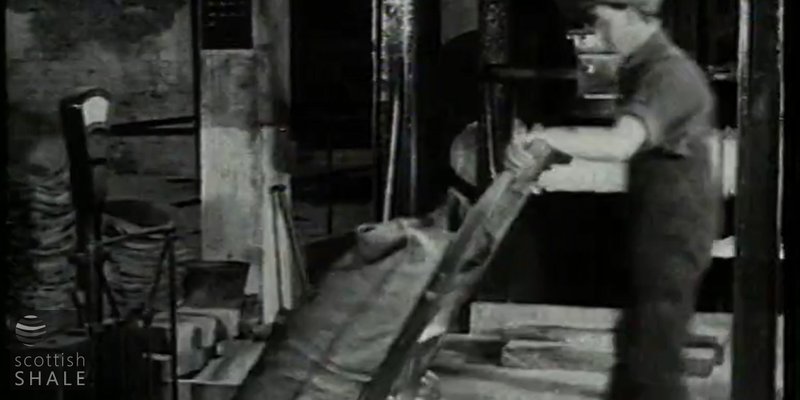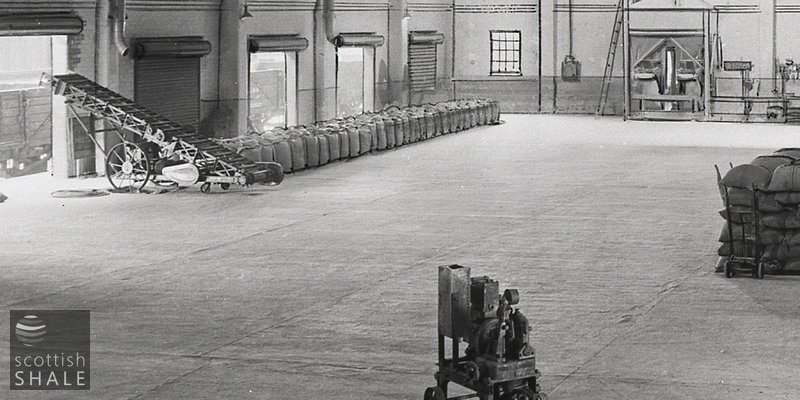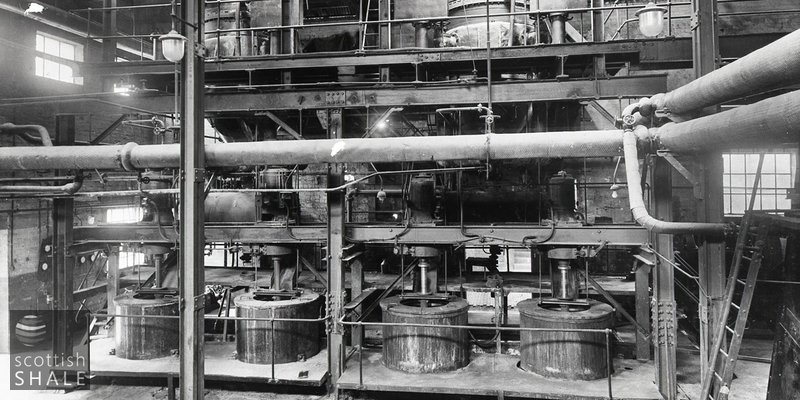Sulphate man
Also known as; - Evaporator man, Sulphate house worker, Sulphate of ammonia maker, Sulphate house worker


Suphate loading shed, Westwood oil works. See full record LVSAV 2019.053

Centrifuges, rotary drier evaporators, and aspirators. See full record; LVSAV2019.037
Associated jobs; - Sulphate of Ammonia drier, Sulphate filler, Sulphate house bag stamper
Ammonia released from shale during the retorting process was expelled as vapour from its solution in a still. It then absorbed in sulphuric acid and water in lead lined vats. This solution was then evaporated to form crystalline ammonium sulphate which was then separated, washed then dried by centrifugation and rotary drier evaporators above and aspirators and centrifugal dryers below
Wages & Working Hours
In 1958, an Agreement Between the Scottish Shale Oil Companies and the National Union of Shale Miners & Oil Workers records that an evaporator earned 29s 8d per shift. Day workers worked an average of 44 hours per week (5 days one week and 5.5 days the next week). Three shift or double shift workers worked a 6 day week of 48 hours.
Reminicences:
"The gaffer came to me and says "There's a chance of another job going on, Adam, if you want it!" I says, "Where is it about?" He says, "The sulphate house!" "What kind of job is that then, what is it doing?" "Well", he says, "The sulphate is put up into a hopper, and you are at the bottom", he says, "with a bag, and you put the bag in below, pull the bag off when you think it is about a hundredweight, take it over the scales and weigh it. If it's too heavy, take some off with a scoop 'til you get the right weight, then sew it up with a big steel needle, with string and burl it round about..... and you were left with two lugs (ears) and tie a knot in the end of the string! Two knots......and......wee Jimmy Cross ......was on that job along with me, I think that Jimmy was taking the bags off me, when I sewed them, and he had a two wheel barrow, and he harrowed them across and stowed them ready for dispatching". AG, Oakbank
"I had a job stamping bags. There had been an earthquake in Japan in 1921, and that was where the bulk of sulphate ammonia went to, when I started work. There were big enormous stencils that you had to stamp with, lamp black they called the black stuff, you had to mix it up with naphtha, and brushed and stencilled the name on, and it was either Yokohama or Tokyo that it went to. They nearly always had to be double bagged, that was …. a second hand bag was put on a trestle and then there had to be a new bag pulled over the top of that. Then, of course, the bags had to be filled with the sulphate that came through the mill from the upper storeys of the sulphate house and weighed and I was the man that held the bag open for this Dan fella to weigh the bag. It held 2cwt in each bag, and that was my job, he had his barrel beside him, and that if there was too much in the bag, he put it into the barrel, if there was too little in the bag, he took it out of the barrel and put it into the bag, and they were loaded, five bags at a time, on to a bogie and I operated this lift up to the wagon. I stuck that for a year, and then I got transferred into the engineering shop, where I served my time as an engineer repairist". AF, aged 14, Bag Stamper / Labourer, Albyn Oil Works, 1923
- Oral history transcript: Mr Archibald Fairley
- Oral history transcript: Mr William Getty (Winchburgh)
- Oral history transcript: Mr Adam Greenhorn
- Oral history transcript: Mr Joe Morrison
- Oral history transcript: Mr & Mrs Reid